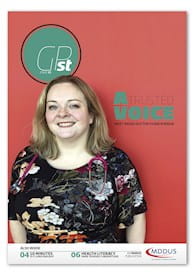 THE job of a GP can be rewarding and satisfying
but with rising workloads and diminishing
resources it has never been more demanding.
As many practices struggle to meet patients’
needs, some are questioning the merits of the
traditional 10-minute consultation.
THE job of a GP can be rewarding and satisfying
but with rising workloads and diminishing
resources it has never been more demanding.
As many practices struggle to meet patients’
needs, some are questioning the merits of the
traditional 10-minute consultation.
Most GPs will tell you about the challenges of trying to fit everything into a single 10-minute appointment. Ten minutes to manage a suicidal patient or a worried mother who presents with her sick baby. Ten minutes to break bad news or deal with the complex needs of someone with multiple comorbidities. Sometimes, well actually most of the time, 10 minutes just simply isn’t long enough.
There has been much debate about how to tackle this issue. Some say slots should be extended to 15 minutes or want a daily set target number of consultations. Others argue for a limit of one problem per appointment.
Resource pressures
There is no legislation or guidance which stipulates that practices must offer 10-minute appointments, and practices could in theory increase their length, but that may not be as simple as it seems. Royal College of GPs chair Professor Helen Stokes-Lampard argues: “Offering longer appointments means offering fewer appointments, and due to the intense resource and workforce pressures currently facing general practice, our patients are already waiting longer than they should be for routine appointments.” In the current set-up, most practices would be unable to offer this.
Equally, limiting patients to raising only one matter at a time may only exacerbate the problem as many would simply book in for second or third appointments to discuss unresolved issues. For some, waiting this extra time could make their health condition worse.
Despite these time pressures, doctors still need to ensure safe practice. Complaints and claims against GPs are rising and not having enough time to properly assess a patient isn’t a valid defence. GPs need to explore practical solutions and work with patients to find a system that eases time pressures on the practice while still allowing them to offer safe care. There are a few things that practices could consider which may ease some of this burden.
Multi-disciplinary team
Patients and practices should make the most of the full healthcare team. Let your patients know which member to consult, and when: whether it’s the pharmacist, nurse practitioner or healthcare assistant. Display this information clearly in the practice or on your website, and ensure reception staff know how other team members can help.
There are some clinical tasks that are best carried out by a GP, but don’t be afraid to delegate (provided team members work within their level of competence and area of expertise). This not only ensures that the patient is dealt with appropriately but also frees up GPs to help those with more complex needs.
GPs also work very closely with their secondary care colleagues and good communication is vital. Patients seen by secondary care or other community teams should understand what treatments are being provided, who is monitoring these and who is responsible for any follow-up care. This will minimise the number of patients contacting their GP just to seek clarification on care offered by other team members, saving vital consultation time.
Telephone consultations
Some problems do not require a face-to-face appointment and can be effectively resolved via a telephone consultation. However, it is crucial that these are used only when appropriate and not just to address resourcing pressures. Telephone consultations have their limitations and patients who need to be examined in person should be offered a face-to-face appointment to ensure GPs continue to deliver safe care.
Be prepared
Time pressures can sometimes leave doctors feeling like they barely have time to draw breath, with as many as 40 or 50 patients coming through their door each day. One option is to set aside protected time prior to the surgery starting for GPs to look through notes and familiarise themselves with the patient. This may seem impractical but it can save time during the actual consultations where the doctor may be asked to look up test results, provide advice following a recent outpatient appointment or even follow-up care after a course of treatment by another GP or healthcare professional.
Be realistic, be safe
GPs usually try to deal with as many of a patient’s problems as they can in one appointment. However, it is important to recognise that sometimes this is neither practical nor safe. Be clear and honest about what you can realistically achieve in the allocated time. Patients are less likely to become frustrated if they understand why you are unable to deal with all their concerns in a single appointment and consider other options you have to address their concerns.
GPs must use their professional judgement, work within their competence and never take shortcuts as a way of dealing with workload pressures. Offering extended/double appointments for those with complex problems is another option. Patients should also be reminded that urgent, same-day appointments are available for more serious issues.
No jargon
The consultation process is based around effective communication and working in partnership with the patient, involving them in making decisions about their care. A full and frank discussion is more likely to ensure a positive patient experience and outcome. Time constraints should never compromise this and it is common for patients to re-attend if they are unsure about any advice given to them. The use of clear, simple and consistent language and avoiding complex explanations or medical jargon can help. It can be worthwhile checking a patient’s understanding of the advice given and plan agreed. This can be particularly helpful when safety netting to ensure they understand the next steps or implications of any red flag symptoms.
Good record keeping
As always, GPs should keep clear, accurate and contemporaneous patient records. Good medical records can ensure that patients receive continuity of care and provide important information to others sharing that patient’s care. Medical records may also be required for legal purposes and are essential in successfully defending medical negligence claims.
Burnout
Dealing with stress and being overworked may be an accepted fact of life for doctors, but there is a tipping point. Burnout can affect a doctor’s judgement, concentration and productivity. All of which can lead to mistakes. General practice cannot afford to lose any more GPs so it is important to recognise factors contributing to burnout and how these can be remedied. Practices should support their GPs but there are other resources out there. MDDUS recently supported the RMBF’s What’s up doc? campaign to help stressed doctors. Find out more at www.rmbf.org/about/our-campaigns/whats-up-doc/
Adapt and change
GPs work extremely hard and the pressures they face are very apparent. It may be time to bid farewell to the 10-minute consultation but making this a reality will not be easy. In the meantime, GPs will have to keep on being their resourceful selves in seeking out ways to continue providing safe, high quality patient care.
Dr Roopinder Brar is a GP and telephone adviser at MDDUS
This page was correct at the time of publication. Any guidance is intended as general guidance for members only. If you are a member and need specific advice relating to your own circumstances, please contact one of our advisers.
Read more from this issue of Insight Primary

Save this article
Save this article to a list of favourite articles which members can access in their account.
Save to library


